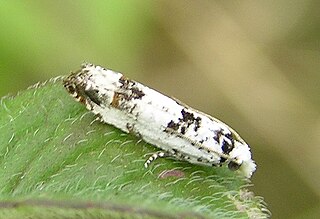
Eucosma is a very large genus of moths belonging to the family Tortricidae. Some taxonomies place a number of species in the genus Eucopina. The genus has a Holarctic and Indomalayan distribution. Even in well-studied Europe and North America, new species are still regularly discovered. There are at least 670 described species in Eucosma worldwide.

Crocidosema plebejana, the cotton tipworm, is a tortrix moth, belonging to tribe Eucosmini of subfamily Olethreutinae. It is found today all over the subtropical and tropical regions of the world and even occurs on many oceanic islands – in Polynesia and Saint Helena for example – but has probably been accidentally introduced to much of its current range by humans. In addition, it is also found in some cooler regions, e.g. in Europe except in the east and north; this is probably also not natural, as it was, for example, not recorded in the British Isles before 1900.

Eucosma campoliliana is a moth of the family Tortricidae. It is found in Europe, China, Japan and Russia.
Eucosma lugubrana is a species of moth of the family Tortricidae. It is found on Sicily and in France, Austria, Italy, Slovakia, Hungary, North Macedonia, Greece and Russia, Kazakhstan and Kyrgyzstan.

Eucosma metzneriana, the mugwort bell, is a species of moth of the family Tortricidae. It is found on Sicily and in Great Britain, the Netherlands, Belgium, Luxembourg, France, Germany, Denmark, Austria, Switzerland, Italy, the Czech Republic, Slovakia, Slovenia, Hungary, Bulgaria, Romania, Poland, Sweden, Finland, the Baltic region, Ukraine, Russia, North Africa, Transcaucasia, Asia Minor, Iran, Kazakhstan, Kyrgyzstan, Mongolia, China, Korea and Japan.

Eucosma pupillana is a species of moth of the family Tortricidae.
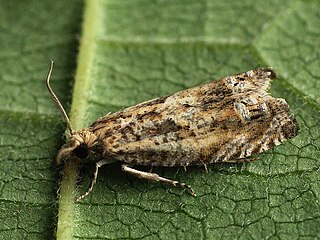
Eucosma aemulana, the obscure bell, is a species of moth of the family Tortricidae. It is found in China, Korea, Russia and most of Europe. It is also found in the United States, where it has been recorded from Colorado, New Mexico, Oklahoma and Utah. The habitat consists of woodlands, chalk downland and cliffs.

Eucosma cana, the hoary bell, is a species of moth of the family Tortricidae.
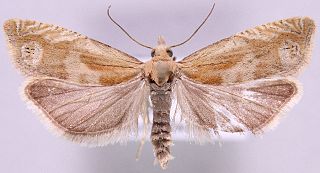
Eucosma hohenwartiana, the bright bell, is a species of moth of the family Tortricidae. It is found in China, Central Asia, North Africa and Europe, where it has been recorded from Sardinia, Sicily, Ireland, Great Britain, Spain, France, Germany, the Benelux, Denmark, Austria, Switzerland, Italy, the Czech Republic, Slovakia, Slovenia, Hungary, Poland, Romania, Bosnia and Herzegovina, Norway, Sweden, Finland, the Baltic region and Russia. The habitat consists of dry open areas and grassland.

Eucosma messingiana is a species of moth of the family Tortricidae. It is found in China, Mongolia, Russia and Europe, where it has been recorded from Germany, the Czech Republic, Denmark, Hungary, Poland, the Baltic region, Sweden and Finland. The habitat consists of sandy areas.

Eucosma dorsisignatana, the triangle-backed eucosma, is a species of moth of the family Tortricidae. It is found in North America, where it has been recorded from Nova Scotia to Florida, west to Texas and north to Manitoba.
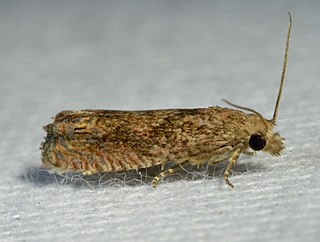
Eucosma floridana is a species of moth of the family Tortricidae. It is found in North America, where it has been recorded from Florida, Mississippi and Oklahoma.

Eucosma giganteana, the giant eucosma moth, is a species of moth of the family Tortricidae. It is found in the United States, where it has been recorded from North Carolina to Florida, Minnesota to Texas, as well as in Pennsylvania, North Dakota and New Mexico.
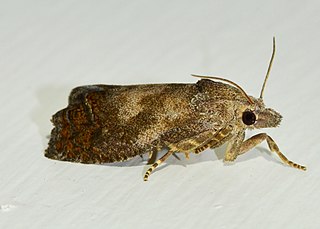
Eucosma sombreana is a species of moth of the family Tortricidae. It is found in North America, where it has been recorded from South Carolina and Oklahoma to Iowa, Illinois and Ontario.
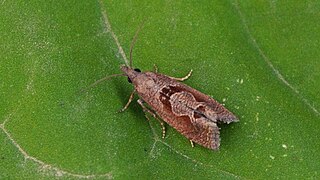
Eucosma similiana is a species of moth of the family Tortricidae. It is found in North America, where it has been recorded from the north-eastern United States and south-eastern Canada. The habitat consists of fields and waste areas.
Eucosma hennei, or Henne's eucosman moth, is a species of moth of the family Tortricidae. Specimens have been recovered in the El Segundo sand dunes in California The habitat includes open sand, undisturbed sand dunes and dense shrubs populated with the larval host plant Phacelia.
Eucosma yasudai is a species of moth of the family Tortricidae. It is found in Russia and Japan.

Eucosma abstemia is a species of moth of the family Tortricidae first described by Edward Meyrick in 1932. It is found in the United States, where it has been recorded from Colorado, Arizona and California.
Eucosma morrisoni, or Morrison's mosaic, is a species of moth of the family Tortricidae described by Thomas de Grey, 6th Baron Walsingham in 1884. It is found in western states North America and from Washington east to Michigan. The species is listed as threatened in the US state of Connecticut.
Eucosma essexana, the Essex phaneta moth, is a species of tortricid moth in the family Tortricidae.














